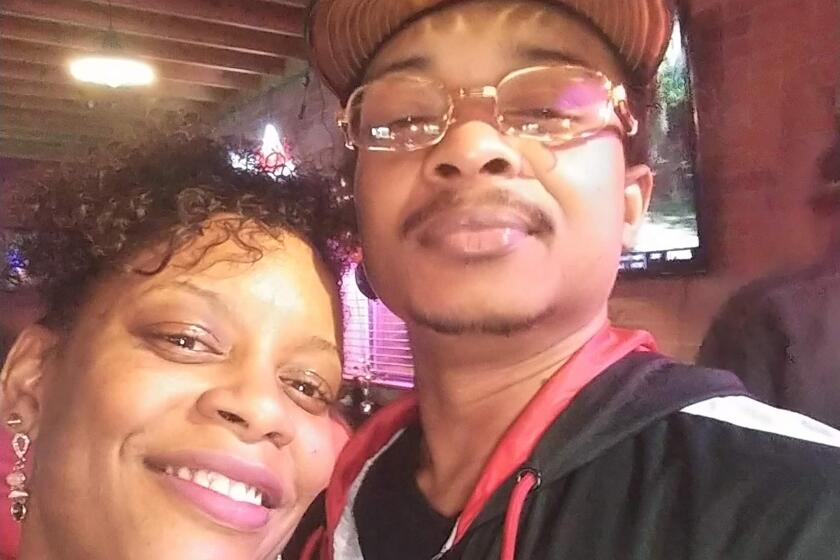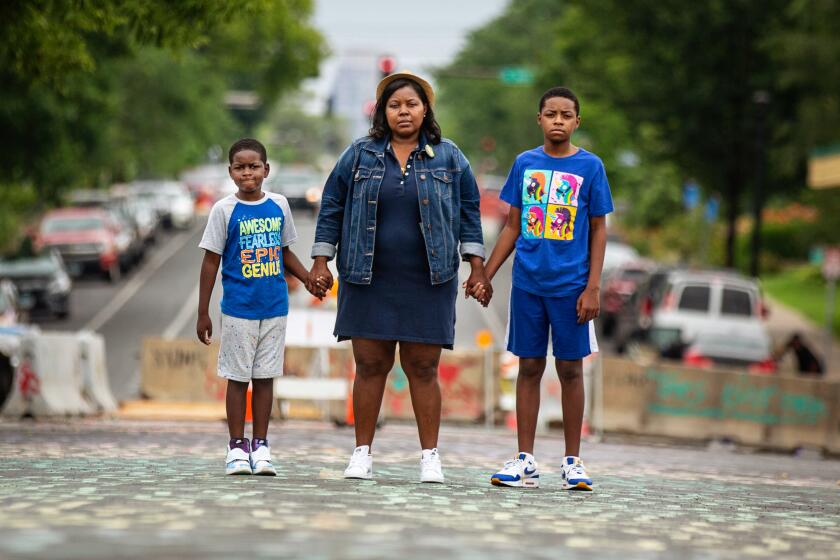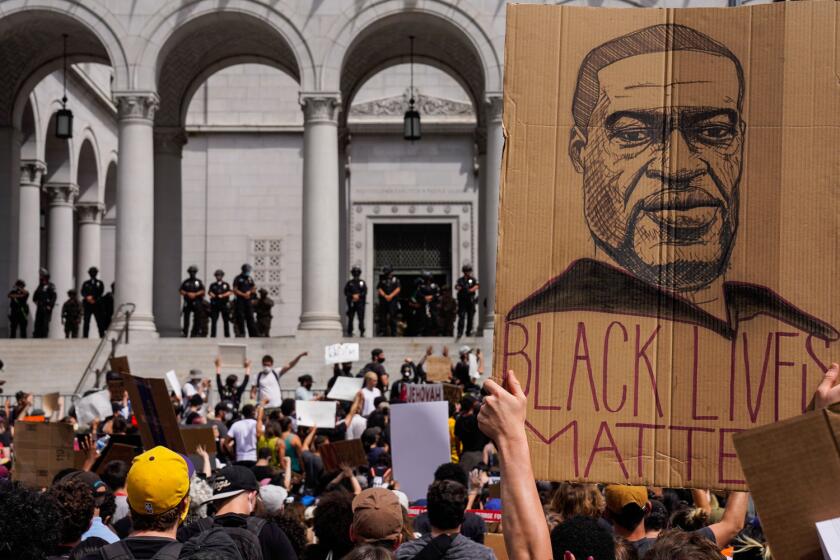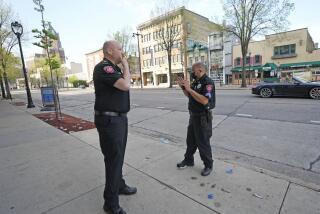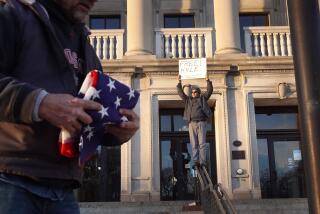Nation’s fierce divide over race and police comes to once-thriving Kenosha
- Share via
KENOSHA, Wis. — In this small city he has called home for 52 years, Alvin Owens stood in front of his boarded-up barbershop. Businesses not far away had been turned to ash. He never figured that kind of fire and rage would land here, but when police shot a Black man this week, all the unspoken things exploded, just as they have across America since the early days of summer.
It’s a moment that hits a man hard, makes him take stock of where he’s from, even here on the banks of Lake Michigan, where one could once pretend, but not anymore, that the nation’s problems involving race and policing reside in other, bigger places.
Two were dead, and one was injured after shootings amid protests in Kenosha, Wis. Kyle Rittenhouse, 17, was arrested on homicide charges.
“I’m angry. I’m sad. I want justice,” said Owens, a Black activist who was tear-gassed as he marched against the police shooting of Jacob Blake, a 29-year-old now left paralyzed and handcuffed to a hospital bed after a white officer fired seven bullets into his back at point-blank range. “I’m shocked at my city. I’m hopeful. I want peace.”
Seven miles southwest, just past the Kenosha city line, Tim Pinter parked his GMC truck to block the entrance to his subdivision. He had come to his own reckoning. He stood guard in camouflage pants and a bulletproof vest, holding a semiautomatic rifle with his 17-year-old son by his side as his wife and other kids slept down the road.
“I’ve shot a lot of guns before, but I’ve never sat outside my home with one,” said Pinter, 47, a white construction worker who has lived here all his life. “I saw what’s happened in Portland, in Minneapolis. I never thought it would come home to us.”
Kenosha, a former industrial town of 100,000, where shift work was an heirloom and unions thrived, is — like much of America — facing a political and moral crossroads. Daytime protests gave way to late-night riots and vigilantes carrying assault rifles. Fires have burned. The mayor is overburdened; the National Guard is in the streets. Racial tensions have sparked anew in a city once sought out as a relative haven from the segregation and crime of Milwaukee to the north and Chicago to the south.
Now, as the nation watches, Kenosha has become the focal point not only of the latest chapter of the American debate over race, policing and protest but also of competing political narratives exposing divisions that have festered over four years and appear certain to resound into the future.

Weeks away from the election, President Trump has singled out Kenosha as he vows to impose “law and order” while his challenger, former Vice President Joe Biden, has demanded that “justice must and will be done” for Blake. Long a Democratic stronghold, Kenosha County flipped red by just 238 votes four years ago in this crucial swing state that Trump barely won.
The pressures haven’t been lost on city leaders and residents in this town unaccustomed to the spotlight, where police, residents and protesters alike said they were shaken and unprepared for the scope of the unrest this week.
“I’m not good at this,” Kenosha’s mayor, John Antaramian, said this week in a public address. “This is not what I’m used to.”
The head of the local NAACP, Anthony Davis, spoke alongside the mayor this week, saying he was disappointed that “Blake being gunned down has turned him into a spectacle.”
Police Chief Daniel Miskinis lamented that his city, “once known for American Motors and the lakefront,” was now “known for violence.”
Anger has erupted in the streets of Kenosha, Wis., after police shot Jacob Blake, a Black man, apparently in the back as he leaned into his SUV.
The U.S. Department of Justice has opened an investigation into Sunday’s police shooting of Blake, who was struck after officers attempted to arrest him on the street while responding to a report of a domestic dispute.
One officer grabbed Blake’s tank top, firing shots into his back as Blake tried to enter his SUV. Three officers are on administrative leave pending a state Justice Department investigation. Officials said Blake had a knife in his car but did not say if the officer knew that when opening fire.
A lawyer for Blake, Benjamin Crump, has described police as “reckless” and said the family will sue.
The shooting of Blake was followed by more bloodshed. Police arrested a 17-year-old, Kyle Rittenhouse, across the border in Illinois on charges of killing two people Tuesday night by an uptown gas station that he patrolled with an AR-15. Videos showed Rittenhouse, a self-styled vigilante, running from people chasing him. He is due in a Lake County, Ill., court Friday for an extradition hearing.
Suddenly, Kenosha was on the map for out-of-towners with varying agendas. Kenosha police said Thursday that they arrested nine people headed toward the city in a minivan, bread truck and school bus with out-of-state plates. Police said they found “gas masks, protective vests, illegal fireworks and suspected controlled substances” in the vehicles.
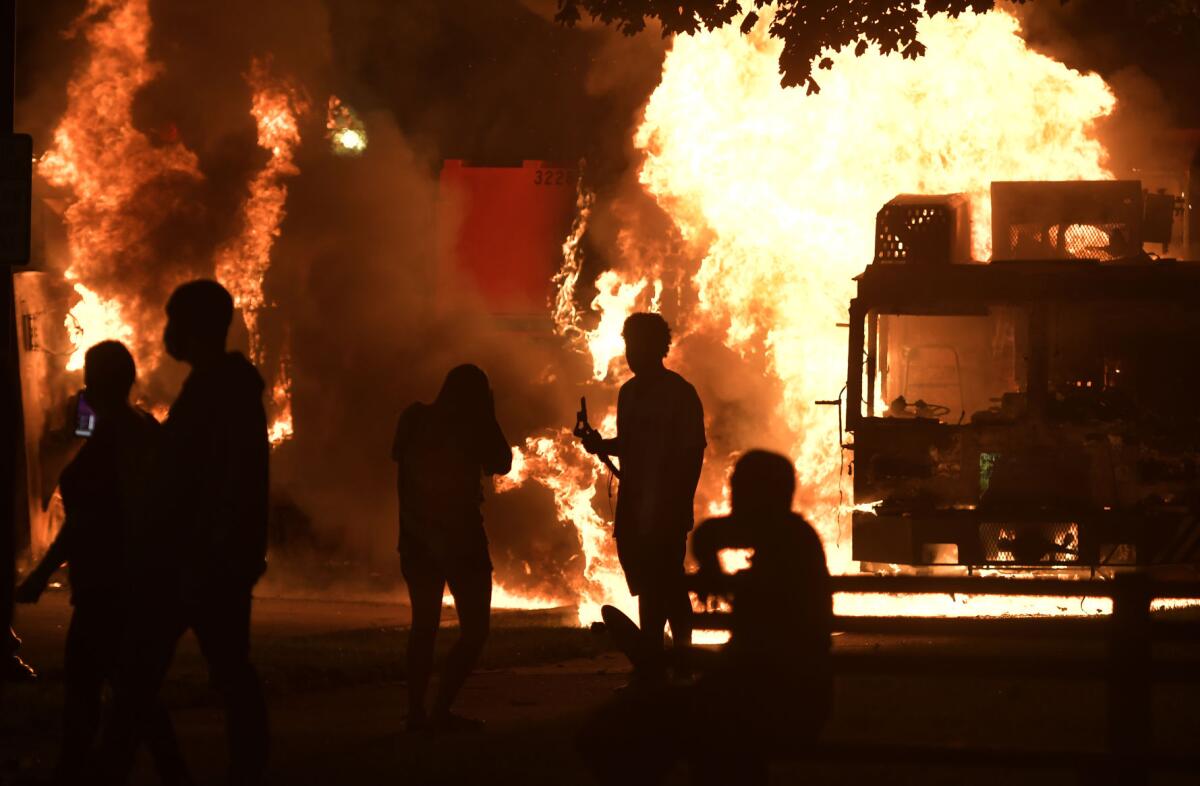
Those arrested face disorderly conduct charges. A Seattle-based group formed this year to feed protestors, Riot Kitchen, said its members who were getting fuel for their vehicles and generator were the ones arrested. The arrests came Wednesday evening, the first night this week without a major incident after a 7 p.m. curfew.
Men like Owens and Pinter wonder when calm will come again, when the Guardsmen and women will depart the streets, the fence around the courthouse will be taken down and hauled away, and protesters with shields and gas masks will run no longer through the haze of tear gas.
Owens, whose Regimen Barber Collective shop and teen resource center was supposed to open with a celebration Sunday for his birthday, now will host Blake’s family for a “Justice for Jacob Blake” march that will leave from his property Saturday afternoon.
The son of a Chrysler autoworker, he grew up as one of nine kids not far from his shop. He said he opened it to “give back to my community.”
It’s down the street from a tiki cocktail lounge mere blocks from Sheridan Road, a main street that’s rapidly gentrified with small businesses over the years, some now burned to the ground. Shops are now boarded up, and owners have painted over the wood with bright murals: “EquALLity,” “#PrayForKenosha” and “vote for change.”
“This is a segregated city, and there’s always been some tension and racism,” he said of the town in a county where 74% of people are white, 7.4% are Black and 13.5% Latino. “This is that kind of place people will move to but then move out five years later, or the place where kids grow up, go to college and never come back. I wonder if more people will now want to leave.”
In Minneapolis, months after George Floyd’s death, Black residents cope with ‘racial battle fatigue’
Protests over the death of George Floyd subside, but the pain lingers. And the COVID-19 pandemic continues to take a disproportionate toll.
The factory where his dad worked, formerly American Motors Lakefront Assembly Plant, attracted thousands to the city and made it a union stronghold before shutting down in 2012. In recent years, newer non-union distribution centers, including Amazon and Uline, have tried to fill the gap that’s still felt today.
The promise to uplift places such as Kenosha, once part of the mighty industrial Midwest, has been key to Trump’s campaign. On Thursday, Owens stood at a news conference as the mayor, the Rev. Jesse Jackson and local and national NAACP leaders admonished community members to vote, saying the president would further fan racial tensions if reelected.
Back in Pleasant Prairie, the suburb popular with sheriff’s deputies where Pinter guarded his street with an armed crowd that had tripled in size over the week, the construction company co-owner who had built several uptown shops said he felt grief for his city, and feared that he and neighbors were being lumped in with vigilantes uptown.
“I feel for the Blake family, but I also don’t want my city, businesses run by people who are my friends and clients, burned down. Let the investigation run its course,” said Pinter, a Trump supporter who said he trusted the president more than his Democratic governor to take care of Kenosha.
Trump’s and Biden’s reactions to racial injustice and protests illuminate how they approached the issue of race throughout their political careers.
A resident of the area for 42 years, who grew up with a dad who was an engineer and a mom who was a teacher, he joined his two brothers who also came out to stand watch.
“I have no intention to hurt anybody, and I think the shootings by that kid this week are horrible,” said Pinter, who said he met with dozens of his neighbors this week, assigning shifts and deciding to communicate with walkie-talkies as they guarded their subdivision of single-family homes.
Though police issued public warnings against armed militias and vigilante justice, open-carry was the law.
“Behind the guns, we’re just regular people,” Pinter said, “who want to keep our families safe.”
More to Read
Sign up for Essential California
The most important California stories and recommendations in your inbox every morning.
You may occasionally receive promotional content from the Los Angeles Times.


